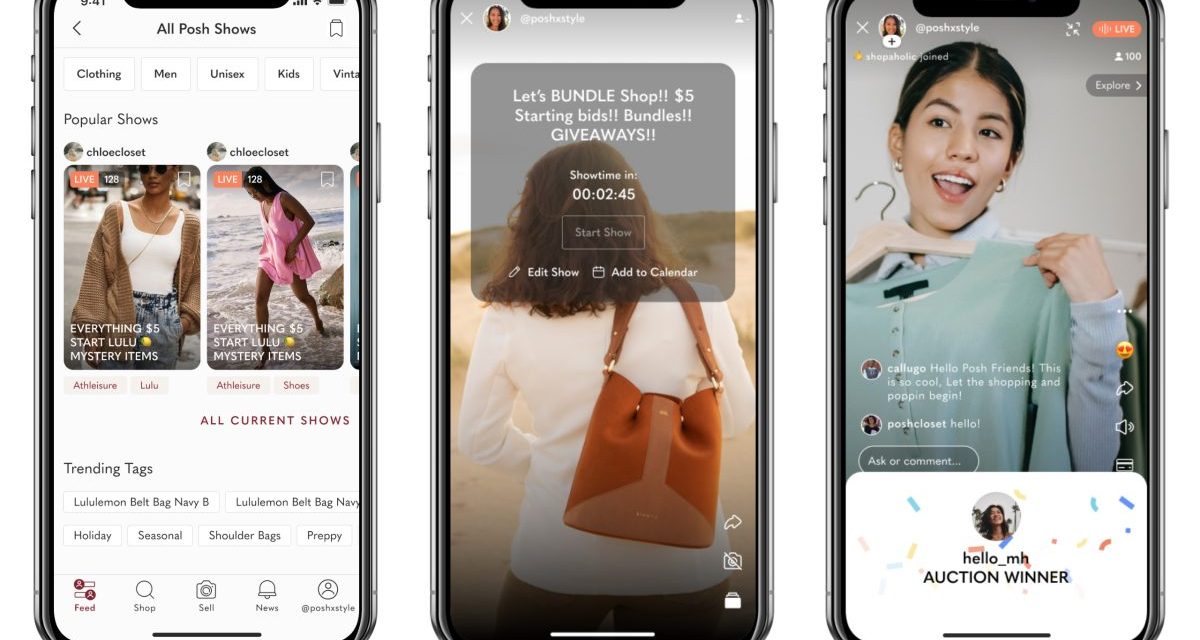Poshmark introduces livestream shopping tool for sellers

On Wednesday, Poshmark unveiled Posh Shows, a program designed for peer-to-peer livestream shopping on the platform.
The new tool will be available in the U.S. and Canada, after being beta tested since the fourth quarter of 2022. Posh Shows allows any user to livestream their closet’s items with a live auction. People without official Poshmark closet listings can also sign up and start listing pieces for sale in real-time. Over the years, the resale platform has added several UX features and programs to help sellers generate more store revenue. With over 100 million users on the platform currently, Poshmark wants to leverage real-time shopping to boost engagement and quicker sales.
Posh Shows’ release comes months after the company, which went public in 2021, was acquired by South Korean tech giant Naver. The sale was completed in January, following Poshmark’s 2022 third quarter earnings release. During the third quarter, Poshmark’s total revenue increased 11% year-over-year, to $88.4 million; The quarterly adjusted EBITDA was negative $8.0 million, compared to $0.6 million in the third quarter of 2021.
Manish Chandra, founder and CEO of Poshmark, told Modern Retail that Poshmark Shows will not only act as an extension of the platform’s existing tools built over the past decade, but also help fold in new users who don’t normally browse Poshmark.
Live video shopping was a trend embraced by many retailers and e-commerce platforms over the past couple of years. More recently, the virtual format has somewhat lost appeal as people have returned to in-store shopping. However, Chandra said Poshmark decided to push livestream shopping after seeing success with other video-based features, like the addition of user stories and allowing sellers to add videos to their listings.
“There is a level of humanity that’s brought out during live interactions,” he said. This aspect is often touted as a major benefit of livestream shopping, which creates a sense of urgency among shoppers wanting to snag a coveted item before it sells. Chandra added that there are some differentiators the Posh Shows brings to the video commerce space.
Once a Posh Show begins, Chandra said, price bidding starts and buyers can buy and bundle items from across different shows to get cheaper shipping rates. “This also allows sellers to partner with shoppers on different deals,” he explained.
The company also hopes the live shows will help organize the vast product categories on the platform. “We have show tags for a lot of different merchandise, like vintage, bags, footwear or popular brands on the platform, like Free People or Nike,” Chandra said.
The Posh Shows tab will be located on the app’s homepage, and feature various live shows that are either happening or coming up. This, Chandra said, allows people to find and join shows featuring products and user closets they’re interested in. During a session, sellers can also pull up and showcase other sellers’ pieces to help them generate traffic and sales; Chandra said this feature can become a major community-building tool.
Posh Shows can also solve some resale pain points that sellers and buyers on Poshmark typically experience. For example, interested shoppers can ask about product fit and styling ideas in real-time without having to wait for the seller to respond in the listing comments.
So far, Posh Shows is showing early signs of success. During the beta trial, Chandra said the company approached specific power users that would be interested in testing the technology. A waitlist of people wanting to try it has accumulated, he said, but the company will be gradually releasing Posh Shows across markets in the coming months.
“It’s one of the fastest growing new products I’ve seen in my career, both in terms of revenue and user base,” Chandra said. The program has been used by over 100,000 users since the beta phase launch.
“We have one seller creating paintings in real time for sale, which is a great way to interact with buyers about the process,” Chandra said. He also pointed to one beta user, Emiley, a mom and full-time Poshmark reseller, whose average monthly sales jumped to $6,000 since using Posh Shows.
As livestream shopping continues to evolve, players are trying to build technology that differentiates them. Yaniv Navot, CMO of experience optimization platform Dynamic Yield, predicts the next phase of live video shopping will revolve around creators and influencers.
Navot explained that while physical shopping is here to stay, some shoppers will carve out other time from their schedule for the right products and shows. “That may be at the end of the day when they’re already catching up on social media or other digital channels or as part of the buying process,” he said. This is where leveraging physical events and purchasing opportunities can come in handy.
Poshmark plans to leverage its popular physical events to help with Posh Shows adoption. These include Poshmark-sponsored live events for sellers, along with in-person local series like Posh and Coffee, which are organized by sellers for their areas.
“There is potential for big international appeal, and we’ve seen people doing full shows in Spanish,” he said. The company is also currently testing the feature in Canada, with plans to to roll out Posh Shows there this year before adding other international markets like Australia.
As Poshmark improves existing features and adds new ones, Chandra said the company is heavily investing in specific areas to improve the Poshmark seller experience. These include video capabilities and quicker payment payouts. “We’re also partnering with Navar on some of the tech infrastructure,” he said. Examples include the new, in-house live streaming capabilities and other upcoming product improvements Poshmark will roll out later this year.
Like its previous releases, Poshmark is hoping the new feature will be adopted and grown by some of the platform’s biggest sellers. “We want the sellers who know how to use live streaming effectively to then teach others about best practices,” Chandra said.

